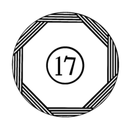On Portraying a Member of the Religious Society of Friends During the American Revolution
My personal re-enacting story is not unlike many, I have always loved history! From an early age, in fact as far back as I can recall my family were taking vacations that always included an historic site in our plans. My mother tells the story that we would visit these places and I would have so many questions but when she didn’t have an answer I would get upset. She soon resorted to purchasing a guide book at every site we would visit. My first taste of the 18th century was Colonial Williamsburg, as time passed my obsession with history was fueled by my family who would buy me books for every occasion, mostly Civil War at this time. The 18th century interest came after seeing the film Last of the Mohicans (I know but we all had to start somewhere) and instantly knew I had to get into the re-enacting somehow… but that would have to wait.
After my Bachelor’s Degree then Graduate School I finally was at a point that I could think about a hobby. The next several years I participated as much as I could attending events with the Maryland Forces, the 3rd Battalion Pennsylvania Provincial Regiment or Augusta Regiment, then Muskets of the Crown, which was my gateway into the Revolutionary War. Then came the ultimate opportunity, at least for me at that time, I met the Augusta Co. Militia, my re-enacting family and friends for life. I fell in with the ACM after being invited to attend an immersion event at Fort Frederick MD. I finally felt like I “fit”! This group of likeminded people with a laser like focus on accuracy, research and authenticity were just the group I was looking for. I have mostly moved my impression(s) away from the military life and more towards the civilian side of things, however I occasionally field with the ACM for militia company or rifle company events but for the most part my uniforms are retired, replaced by civilian clothing.
[gallery ids="3126,3127" columns="2" size="medium"]
So, with that said when, where, and why the Quaker impression? It goes back to an event at Monmouth Battlefield where I knew I could not march nor did I have military gear correct for the impression, so civilian it was and lucky for me there was a need for civilians. There were several impressions available and I chose a New Jersey slave owner so my good friend Anna Gruber-Keifer would have someone to play off her Quaker impression with. It was a good thinking moment and I began to research the Quakers (opens HUGE can of worms) …
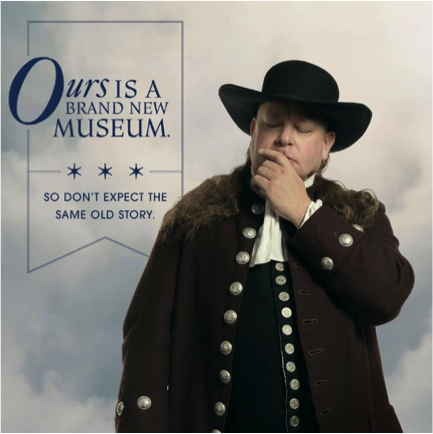
The next event was the “With Peal to Princeton” march and again the civilian contingent came out but accompanied with that was the AMAZING opportunity to be involved with a promotional shoot for the Museum of the American Revolution. I was asked if I could portray a Quaker, I said yes and knew to do it right I would have to do my homework. I as many had the vision of the Quaker Oats Man in my head as the essential costume of a colonial Quaker. Well I needed to start digging for a better basis than that.
One of the few images available for Quakers of the time is found in the Museum of Fine Arts Boston, by an Unidentified Artist. It depicts a Quaker Meeting with what appears one individual standing to give a Testimony. Here was my start, the “plain” attire consistent with the Testimony of Simplicity showed that my brown coat and black waistcoat could work. I would need to construct some breeches for the shoot. Additional research on Quaker dress of the period soon enlightened me further. Although plain dress alone does not make one a Quaker, it was simply an outward expression of faith and adherence to the tenants of the faith.
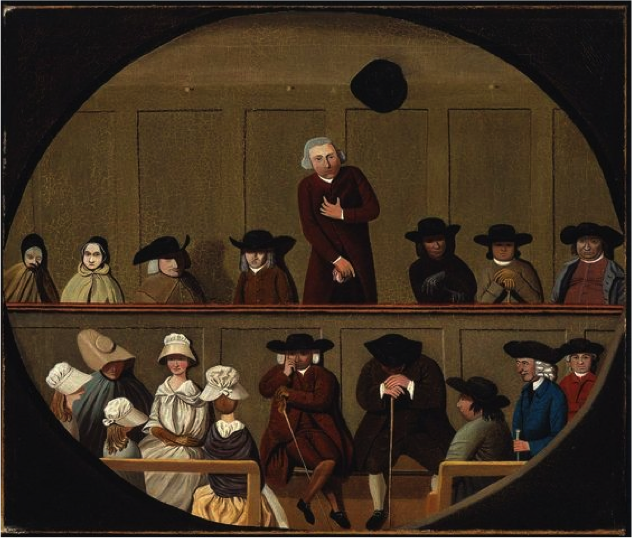 So profound was the dress that several 18th century authors made mention of it. One example comes from John Wesley (1703-1791) in The Sermons of John Wesley, Sermon 88, On Dress when he encourages his congregation to dress like the Quakers:
So profound was the dress that several 18th century authors made mention of it. One example comes from John Wesley (1703-1791) in The Sermons of John Wesley, Sermon 88, On Dress when he encourages his congregation to dress like the Quakers:
"I conjure you all who have any regard for me, show me before I go hence, that I have not laboured, even in this respect, in vain, for near half a century. Let me see, before I die, a Methodist congregation, full as plain dressed as a Quaker congregation. Only be more consistent with yourselves. Let your dress be cheap as well as plain; otherwise you do but trifle with God, and me, and your own souls. I pray, let there be no costly silks among you, how grave soever they may be. Let there be no Quaker-linen, -- proverbially so called, for their exquisite fineness; no Brussels lace, no elephantine hats or bonnets, -- those scandals of female modesty. Be all of a piece, dressed from head to foot as persons professing godliness; professing to do everything, small and great, with the single view of pleasing God"
(emphasis mine)
In his text “Letters From An American Farmer”, J. Hector St. John De Crevecoeur (1735-1813) writes: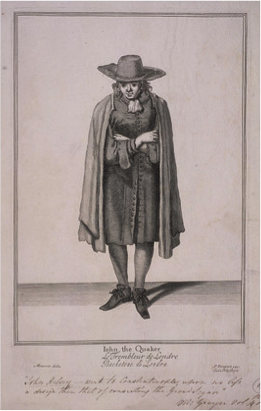
The manners of the Friends are entirely founded on that simplicity which is their boast, and their most distinguished characteristic; and those manners have acquired the authority of laws. Here they are strongly attached to plainness of dress, as well as to that of language;
Additionally I found this description of Quakers from Thomas Clarkson (1760-1846) In his book “A Portraiture of Quakerism, Volume 2 published in 1806.
"Peculiar Customs" begins with dress.
"The dress of the Quakers is the first custom of this nature, that I purpose to notice. They stand distinguished by means of it from all other religious bodies. . . . Both sexes are also particular in the choice of the colour of their clothes. All gay colours such as red, blue, green, and yellow, are exploded. Dressing in this manner, a Quaker is known by his apparel through the whole kingdom. This is not the case with any other individuals of the island, except the clergy . . ."
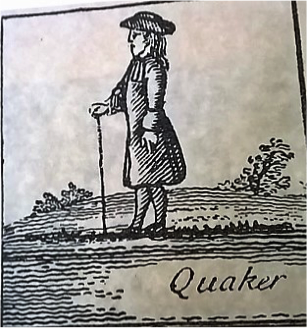
The Quaker impression went over well at Princeton, and the photos were used in a promotional campaign for the new museum. At Princeton, we had some great crowd interaction on the streets and even had the headmistress of the Friends School adjacent to the battlefield come up and engage me and others in some very meaningful conversation. With fuel for the fire I began reading more and researching the Quaker belief system, its origins, its impact on the Revolution etc.
To talk about all aspects of the Quaker religion, its impact on the social and political environment of the American Revolution is well beyond the scope of this post or my limited knowledge. I have, however over the past year begun to dig more deeply, not only on the Quaker faith but its history and impact on history. Some notable Quakers from this period were Thomas Paine author of Common Sense and American General Nathanael Greene. There are examples of Quakers participating on both sides of the conflict. As well as Quaker persecution by both sides. The most common reference to this I have found so far was regarding the “taking of oaths” which is against Quaker teachings. This led many in the faith to be branded as Loyalists and vice versa. I believe this is a good example of the difficulties many Quakers may have faced in keeping strong in faith while living in a “world turned upside down”. Recollections of the war were recorded by the likes of Phebe Mendenhall Thomas, Joseph Townsend, and Daniel Byrnes all of whom were present at the battle of Brandywine. Their stories shed some light into the thoughts and feelings of Quakers before during and after the battle.
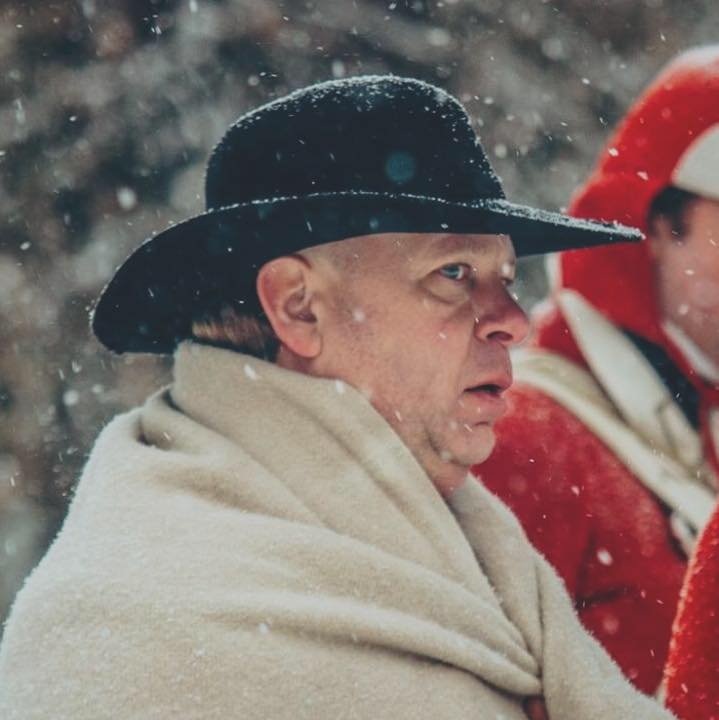
I have always been fascinated by religion from an historical perspective so digging into the Quaker belief system was only natural for me. Although not a practicing Quaker in any stretch of the imagination, the idea of attending meeting now and again if for nothing else but to sit quietly and reflect seems a very inviting opportunity. I'll report back if there is interest in my experience.
There are always common questions from the public that arise when I put on my “Quaker” kit. I get a lot of “who are you?” or “what are you doing here?” this one is especially true when at military specific re-enactments. Through trial and error, I have learned it is a good idea if one is going to represent a religion or its members, you had better know as much as you can about that religion. This is one aspect of portraying a Quaker that is an even bigger challenge for reenacting and public interactions. Here in Pennsylvania I have noticed that more often than not, you will come in contact with someone who is either a Quaker or has been exposed to the Quaker religion via a friends’ school etc. So, knowing what you are talking about IS VERY IMPORTANT.
One of the most common question that came up on a trip to the Museum of the American Revolution opening weekend was; “are you Ben Franklin?” As I don’t think myself looking much like this founding father except my generous size, I would explain “no I am portraying a member of the Religious Society of Friends or a Quaker”. Many times, this would be the end of the conversation, but I try to engage the public whenever possible throwing out the bait as to just how did the revolution impact this social, religious and political group of people and vice versa. The individual stories aside, one of the primary areas of conversation I try to engage the public in is the idea of being true to one's beliefs in a world of political change and upheaval? To me this presents a huge talking point and draws some direct relationships between the world of Revolutionary America and the America we are experiencing today.
I take re-enacting not so much as a hobby to be enjoyed on the weekends but more of a calling. I put time and effort not only into my clothing, and elements of material culture, but into my interpretation to the public. I try NOT to perpetuate falsehoods or keep the stereotypes going. I am always trying to learn, expand my knowledge and engage people in the subject I have such passion about. I know I am no expert, I am no classically trained historian I am an amateur at best but I respect the people, places, and things that constitute our collective narrative and strive to present that to those who are willing to listen.
 BRANDYN CHARLTONBrandyn is a father of three Cora, Clare and Liam, he and his wife Danielle reside in Northumberland Pennsylvania on the Susquehanna River. He has a Bachelor’s degree from Ohio University and a Master’s degree from Edinboro University of PA. He has been a Certified Athletic Trainer for the past 21 years working in the clinical, high school, and collegiate practice settings.
BRANDYN CHARLTONBrandyn is a father of three Cora, Clare and Liam, he and his wife Danielle reside in Northumberland Pennsylvania on the Susquehanna River. He has a Bachelor’s degree from Ohio University and a Master’s degree from Edinboro University of PA. He has been a Certified Athletic Trainer for the past 21 years working in the clinical, high school, and collegiate practice settings.
He currently works in the occupational/industrial setting providing ergonomic services to clients in the Harrisburg area.
